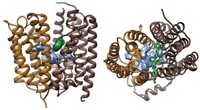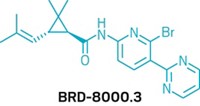Advertisement
Grab your lab coat. Let's get started
Welcome!
Welcome!
Create an account below to get 6 C&EN articles per month, receive newsletters and more - all free.
It seems this is your first time logging in online. Please enter the following information to continue.
As an ACS member you automatically get access to this site. All we need is few more details to create your reading experience.
Not you? Sign in with a different account.
Not you? Sign in with a different account.
ERROR 1
ERROR 1
ERROR 2
ERROR 2
ERROR 2
ERROR 2
ERROR 2
Password and Confirm password must match.
If you have an ACS member number, please enter it here so we can link this account to your membership. (optional)
ERROR 2
ACS values your privacy. By submitting your information, you are gaining access to C&EN and subscribing to our weekly newsletter. We use the information you provide to make your reading experience better, and we will never sell your data to third party members.
Antibiotics
Movers And Shakers
Stephen Cochrane kills bacteria by thinking outside the cell
The organic chemist searches for antibiotics that attack bacteria’s membranes rather than their inner proteins
by Geoffrey Kamadi, special to C&EN
February 16, 2024
| A version of this story appeared in
Volume 102, Issue 5

Note: No experiments were taking place in this lab, and all hazardous chemicals were safely stored before this photograph was taken.
Antibiotics researchers have long focused on the proteins inside bacteria, hoping to find a key piece of the bacteria’s molecular machinery that, when disrupted, kills the bugs and cures infections. But that process requires that antibiotic molecules cross the bacteria’s cell membrane to reach those targets. Once inside, the antibiotics face a slew of proteins and other defenses that bacteria have evolved to neutralize their would-be killers.
Stephen Cochrane of Queen’s University Belfast is thinking outside the box. Instead of sending molecules into bacteria, Cochrane designs and builds compounds, like peptides, that kill bacteria by binding to the lipids that form their outer surfaces. He says this approach can uncover drug candidates that bacteria have a tougher time developing resistance to because membrane lipids tend to evolve more slowly than internal protein defenses.
With a €1.5 million ($1.6 million) grant from UK Research and Innovation, he plans to lead a research effort dubbed New HOPE (Approaches to Overcome the Problem of Antimicrobial Resistance) to find membrane-targeted antibiotics. His team of five early-career researchers aims to create tools that will enable chemists to discover and develop membrane-targeted drugs.
Geoffrey Kamadi spoke with Cochrane about why we need a new approach to antibiotics, what sorts of drugs could be out there, and his plan for the 5 years of his project. This interview was edited for length and clarity.
Vitals
▸ Hometown: Derry, Northern Ireland
▸ Current position: Associate professor of organic chemistry and chemical biology, Queen’s University Belfast
▸ Education: MSci, chemistry, Queen’s University Belfast, 2010; PhD, organic chemistry, University of Alberta, 2015
▸ Favorite molecule: Undecaprenyl phosphate. It’s amazing how such a simple molecule acts as the linchpin for many bacterial glycopolymer synthesis pathways.
▸ Trickiest bacterial target: Intracellular enzymes because there are so many different ways that bacteria can protect them from antibiotics.
▸ Hobbies: Long-distance running. My current marathon personal best is 02:39:07.
▸ Best professional advice you’ve received: Use every rejection as a learning opportunity to improve your next grant application or paper. Also, don’t take it too seriously.
Given the number of different antibiotics sold today, why try to make new ones?
Since the golden age of antibiotics [roughly 1950–60], we’ve found that resistance has been developing at a faster and faster rate. The UK government did a report in 2014 which predicted that, if resistance continues at the current rate, by 2050 it will cause 300 million premature deaths and cost the global economy over $100 trillion.
We can’t just make antibiotics and then sit back and say, “OK, these will do the job.” We need to be coming up with antibiotics that act via new mechanisms. If you make an antibiotic that is structurally like anything that exists—say, like a β-lactam—it is acting on the same targets. So resistance is going to happen more quickly with those types of compounds. You want something that is new, that cells haven’t seen before.
How is your lab’s approach different from previous antibiotics research efforts?
For decades, extensive efforts have been made to develop antibiotics that target proteins inside cells because the types of technologies needed to do a variety of fluorescence-based protein assays are well established. But it is different for cell membrane targets.
A membrane target isn’t a protein; it is a lipid embedded in a cell membrane. It has a polar head group where the antibiotic can latch on. The problem is that there hasn’t been a concerted effort to discover new compounds that target these membrane targets because the tools needed to do that haven’t been accessible.
And so what my research aims to do is develop new tools, almost like a sieve, to be able to filter through compound libraries and find compounds that bind to these targets. What we are doing is taking a particular lipid target in the cell membrane and using organic chemistry to add a fluorescent reporter to the polyprenyl tail that anchors these targets to the cell membrane. Whenever we identify an antibiotic that binds to the head of a target, the lipid emits a fluorescent signal that we can detect.
These targets are being screened mostly in multiwell plates, but we hope to also develop chemical probes to study processes in cells.
What kind of antibiotic candidates has your membrane-targeted approach opened the door for?
In general, larger molecules—things typically above 500 Da—can’t pass through cell membranes passively. So if the target is inside the cell, it limits a lot of the different types of structures that we can use as drugs.
Because we don’t need to get these compounds through the cell membrane, we don’t have to worry about size. We can get much bigger, complex scaffolds that are going to have more parts binding to the target.
When I teach this concept to students, I use the analogy of a giant squid attacking a boat versus a shark attacking a boat. When a shark attacks, there’s only one attachment point, and any mutation or modification of the target blocks binding. In contrast, when a giant squid gets all its arms around a boat, it doesn’t matter if one or two arms are blocked. It’s still bound to the boat. Nonribosomal antimicrobial peptides are a major family of compounds that operate like this.
What are your first steps as you plan to use the new grant?
In the first 1 or 2 years, we are going to develop the chemistry needed to make tools for discovery. We are then going to use the tool kit to do two kinds of broad things.
In collaboration with Foundation Medina in Spain, we will use the tools to screen their natural product libraries. They are world leaders in natural product discovery. Also, our team will be looking at developing a new and much more efficient way to chemically synthesize these membrane targets. Because for us to develop tools, we need to be able to synthesize the targets we are interested in.
In another branch of the research, we are going to look at different enzymes that process or make some of these targets and see if we can use our tools to develop new assays to find inhibitors for those enzymes. So, 2 to 3 years will be tool development, and then years 4 and 5 will be using the tools to find new antibiotics.
What do you hope to achieve by the end of the 5-year project?
I hope to have a number of new antibiotic candidates that operate by new mechanisms. And by the end of this project, we will develop chemical tools that can be used by researchers around the world to screen for new compounds with membrane targets.

I am very optimistic we will find something new. I can’t say for certain whether that then will become a new antibiotic, because of course that is a much different challenge. But I don’t think it is intimidating at all. I really enjoy the work I do. I mean, I am a scientist primarily because I am curious about different things. It’s good that my curiosity is piqued by ways to kill bacteria.
Geoffrey Kamadi is a freelance writer based in Nairobi, Kenya. A version of this story first appeared in ACS Central Science: cenm.ag/newantibiotics.
UPDATE:
The caption of this story was updated on March 20, 2024, to clarify that in the photograph of Stephen Cochrane, no experiments were taking place, and all hazardous chemicals were safely stored.





Join the conversation
Contact the reporter
Submit a Letter to the Editor for publication
Engage with us on Twitter